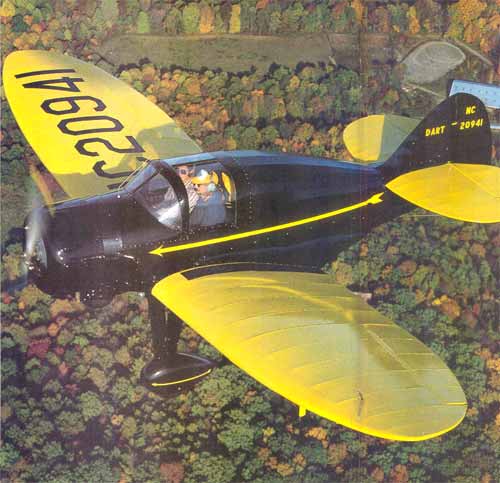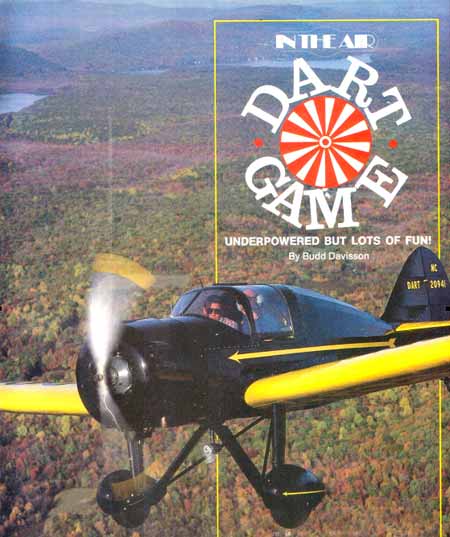PAGE TWO
 |
The wing planform with that
tiny round cowl really gets to you, doesn't it? |
As I squeezed into the tiny cockpit of Dave Foulke's Warner-powered
Dart, I constantly reminded myself of the story he had just finished
telling: After totally rebuilding the airplane, he propped the airplane
with a pilot on board. The pilot panicked and, for some reason jammed
the throttle to the stop, eventually impaling the Dart in a hangar
wall, necessitating a second rebuild. I told myself I was not about
to become the second guy to break one of Dave Foulke's airplanes. He
spent far too much time making this airplane original for me to want
to take a chance on bending it up so I put Dave on the left where the
only set of brakes were :located.
When rebuilding it the last time he tried so hard to make the airplane
original that he called the airport in North Dakota where the airplane
was originally delivered in 1938 and asked for the name of the oldest
active pilot in the area. He came up with a man who had lived across
the street from the airport when the airplane was delivered and, as
a kid, stood and watched the machine take off and land many times.
That's where Dave got the original design for the black and yellow
paint job.
Strapping in, I couldn't help but laugh. I had first seen the airplane
two years earlier at Oshkosh and had tried to locate the owner with
absolutely no luck. Then, a year later, I saw the same airplane at
Blakesburg but the heat, weather and schedule prevented
us from doing anything constructive. Then, out of the blue, I received
a letter asking me if I wanted to get together to fly the Dart. And
it turned out Dave's address was only about eighty miles over the hill,
which goes to show you never really know what's in your own backyard.
The first item on the start-up check list was to screw a big spigot
handle out of the left side of the instrument panel, which turns on
the oil to the engine. Dave always shuts off the oil as he shuts down
the engine because that prevents the bottom jugs from loading up. The
onboard starter is a post accident addition that puts him more in control
of his airplane's destiny. Even though the airplane sets fairly' flat
on the ground, compared to some tail-draggers, that little round engine
and the fact that the plexiglass keeps you from moving your head very
far to the side, makes it difficult to tell for sure what you are taxiing
over and into. In fact, it reminded me a lot of my old 195. You could
see what was straight in front of you by squeezing to the side, but
there was no way you could see anything shorter than a skyscraper on
the opposite side of the airplane. So you do a reasonable amount of
S-turning to prevent close encounters of the expensive kind.
Dave was continually commenting about how much I weighed, how hot it
was, and how short the runway was. And when we taxied down to takeoff,
he made sure we were clear off the end of the runway to take advantage
of every foot available. We had 2,000 feet in front of us but, the
way he talked, I kept looking down to see if we were going to have
to pedal to get this thing off the ground or would the little Warner
handle the chores. I didn't know what to expect with all this build-up,
but as the throttle went forward, it was obvious I shouldn't have expected
too much. At an empty weight just a shade under 1,000 pounds, that
put us pretty close to the 1,500 pound gross as we were rolling down
the runway with only 90 hp chugging away up front. Acceleration was
leisurely, to say the least, but the little cornpopper got us off the
ground in a decent amount of time; it just wasn't about to yank us
up to altitude like a Pitts. But, of course, at the 60-65 mph we were
using for climbing, the Pitts would have stalled out several mph ago
Lots of times you look at an airplane, especially an old one, and you
grit your teeth, knowing that even though it's a beautiful airplane
it may not fly as its looks advertise. Often I've been disappointed
with the control response of airplanes but, at this point, as I was
straining to get 1,000 AGL, I found the only area in which the Dart
let me down was its power. The controls were surprisingly swift and
clean. In fact, the ailerons were so nice that it was all I could do
to keep it upright throughout the flight. Although the airplane is
fully stressed for aerobatics, and has been used many times for that,
I didn't feel like playing the acro game with an engine that wasn't
about to give me back the altitude I'd have to give up in the entries
to maneuvers.
When flying the airplane, I wasn't as aware of the plexiglass as I
had been down on the runway. It curves in fairly tight and what is
a small cockpit at shoulder height becomes a miniscule cockpit at head
height. This is one place where six footers need not apply or risk
becoming a hunchback. Also at altitude I didn't notice the heatwave
I first felt pouring from the back of that Warner as we brought the
power up on takeoff. What I did notice, however, was the large amount
of nose coming from such a small source. A good set of Dave Clarks
and an intercom system would be a welcome addition if Dave spent much
time running across country with a copilot, which he doesn't.
With the little ninety horse engine, it is certainly no speed
demon. Dave's airspeed is nowhere close to being correct but, when
we later paced it with a camera plane, it seemed that 85-90 mph was
about all we were going to get out of cruise. With a bigger engine,
however, cruise is an entirely different story and the same thing is
true on climb-out. The 120 horse Ken Royce versions reportedly
climb at 1,500 feet a minute on takeoff, which beats the hell out of
the 300-400 feet we were seeing. It is really a shame that our business
schedules often dictate those important moments of our lives that we
should be enjoying, but Dave and I both had to be back to the barn
in a very short time to take care of prior commitments.
As we came over the airport and entered downwind, Dave was continually
stressing how important it was to keep the speed down to 60 mph on
approach. With those long, incredibly fat wings, even an extra four
to five mph translates into a huge amount of float, something which
we couldn't afford with only 1,900 feet of runway and a lake at each
end. As we came down final, Dave worked us down to where we were going
for a number one wire, right on the edge of the lake. Having made that
approach many times in various airplanes, I was at first a little spooked,
thinking we were short. But, the airplane fooled me and was not going
to land on the spot that stayed stationary in the windshield. In fact,
it would have glided right over that point if we hadn't slipped. Dave
says when he's up alone with low fuel, approach speed is really critical
for any kind of a normal landing, although it slows to a virtual stop
before actually touching the ground. Once on the ground, it tracks
straight on its own accord, which is lucky because the tail is pretty
short and the heel brakes are next to useless because of their position.
Do I like the Dart? Well, I just sent a bunch of money to Lloyd Washburn
for a copy of the original factory plans (Lloyd Washburn, 3958 East
Washburn Drive, Port Clinton, Ohio 43452) knowing full well they are
anything but up to date. They are, in fact, twenty sheets of drawings
that the original airplane was probably built from, so there
have been many updates that don't show. I, however, love having that
type of thing in my daydream file and will periodically pull them out,
and think, gee, wouldn't it be neat to put one of these little dudes
together with a 165 Warner or, if I wanted to bastardize it a little,
with a 150 Lycoming. There are certainly faster, more modern, homebuilts
that I could get involved in, but none came to mind that have the elan
and cute-as-a-bug elliptical wings, it would certainly be no more difficult
than many homebuilts, and would be much more distinctive. With a few
minor modifications you could have yourself a really neat, fully aerobatic
cross-country machine that would allow you to pull up to the local
gas pumps without fear of having another one pull in at the same time.
The Dart is a phenomenally good looking little airplane in an indescribable
sort of way and, fortunately, it flies the way it looks. Well, let
me see I figure I'll finish the Howard Pete by the turn of the century
and there's the artillery piece to finish and the two midget race cars.
So I've got enough time left in my lifetime to build a Dart. At least,
I ought to make time. (Ed. note from 2008: guess
I was wrong about having enough time.)
For
lots more pilot reports like this one go to PILOT
REPORTS
|

